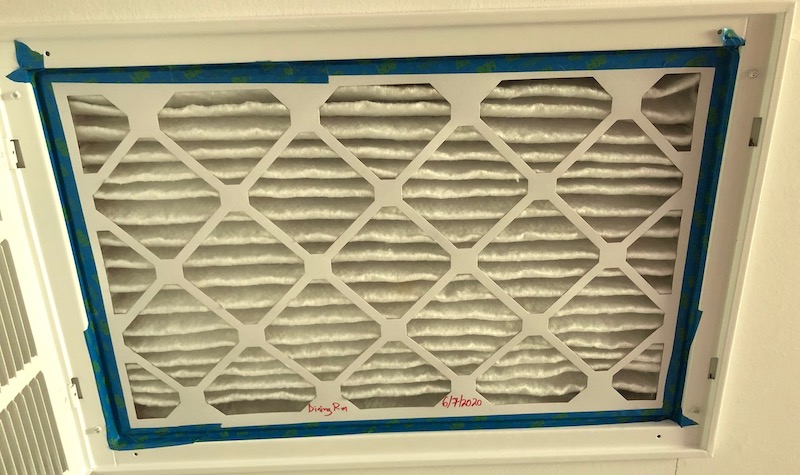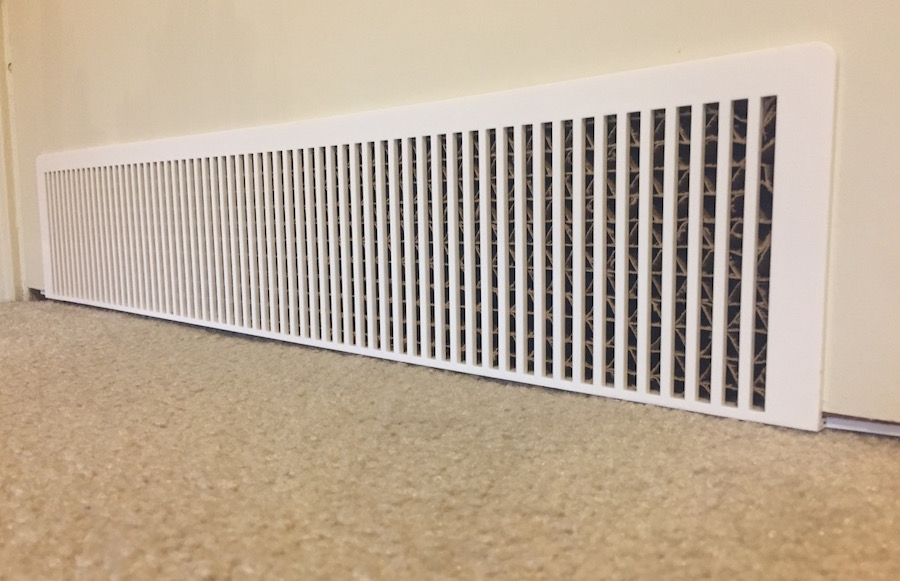
The central vs. dedicated return vent debate has a clear winner. But first, let me explain the terminology. A forced-air heating and cooling system has supply ducts that blow conditioned air into the rooms of your house. That’s the part that’s obvious to most people. But that air has to come from somewhere. On the other side of the heating and cooling equipment is the return side of the duct system. It returns air to be conditioned again.
One way of designing the return side of the system is to use a central return. This design may have a single return vent, or it could have multiple return vents. In either case, the returns will be in the common areas of the house. The system serving the bedrooms in my house, for example, has a central return in the hallway.
The other way to design return air is with dedicated returns. That is, each bedroom has its own return vent sending air back to the system to be heated or cooled. A house with dedicated returns in each bedroom still will have more return vents in the common areas.
Of the two types, one has significant advantages. Can you guess which one it is?
The central return’s bad rap
The central return is common on most older houses. It’s also common in “starter homes” and other less expensive houses. Because of that, some people think of a house that doesn’t have dedicated returns as being cheap or out-of-date. We occasionally have HVAC design clients who tell us they want dedicated returns because they don’t want the house to seem cheap.
Another knock on the central return is noise. I can empathize with that sentiment because I used to live in a condo with a noisy central return. It was right below the TV in the living room, and we’d have to turn up the volume whenever the system started running.
A final drawback of the central return is that it can cause airflow problems and pressure imbalances in the house. This problem arises when you put conditioned air into a closed bedroom and don’t have a way for that air to get back to the central return. The bedroom will build up a positive pressure. The area near the central return will develop a negative pressure. The imbalance can reduce airflow, increase air leakage, and possibly even cause backdrafting of a combustion appliance. That last one can be dangerous, as it could put carbon monoxide in the house.
When you think about the central vs. dedicated return debate, though, what are the real problems here?
Why a central return is better
One reason to go with a central return is that you’ll end up with less ductwork. Shorter ducts on the return side can mean less resistance to air flow. It’s certainly possible to do low-resistance dedicated returns, but it’s generally easier with central returns.
Central returns also can mean less energy loss if the ducts are in unconditioned space. Even though return air is not as cool or as warm as the conditioned air in the supply ducts, it still can be a lot cooler or warmer than the air in an unconditioned attic, crawl space, or basement. That means conductive heat gain or loss. Of course, you shouldn’t put ducts in unconditioned space at all, but many houses do have that problem.
Another type of loss that happens in the return ducts is through leakage. Yes, ducts should be airtight with no leakage. But the shorter your return duct system, the fewer connections there will be to seal. Also, leakage on the return side will suck in air from the surrounding space, which can cause indoor air quality problems.

And speaking of indoor air quality, central returns are a great way to be able to use high-efficiency filters (MERV-13 typically). The problem with trying to use high-MERV filters is that the resistance to air flow through them is too high. Increasing the filter area is the solution here. When it comes to central vs. dedicated return vents, the central return makes that easier.
Instead of putting the filter(s) at the air handler, you put it (them) at the return vents. The photo above shows one of the filter grilles in my house, and I’ve sized them to have a lot of filter area relative to the airflow rate. Yes, you can do that with dedicated returns, too, but then you have more filters and probably different sizes as well. We like to size all our filter grilles the same so the homeowner can buy all the same size filters.
How to make a good central return
The central return’s bad rap is the result of poor duct design. Fixing the design problems can fix the perception problem, too, so let’s see what you need to do. There are basically two things to pay attention to.
Fixing the noise problem is easy. Noisy return vents are mainly the result of the blower being too close to the return grille. The solution is to put some distance and a couple of turns between the grille and the blower. Another way to reduce the noise is to size the system properly. Oversized systems have bigger blowers, and bigger blowers are noisier. Even better, use a small-capacity, variable-speed system (minisplit), which is quieter than a conventional system.
![Jumper duct in attic [credit: Mike MacFarland]](https://images.greenbuildingadvisor.com/app/uploads/2022/06/01115937/jumper-duct-mike-macfarland-700x525.jpeg)
One way to provide a return-air pathway is to use the gaps around the bedroom door. We usually talk about this return-air pathway as a door undercut, but air can move around the sides and top of the door, too. Interior doors aren’t weatherstripped and usually don’t fit tightly in the frame, so air can get through all four sides. This method won’t work with all bedrooms, though. The amount of supply air put into the bedroom has to be fairly low.
Another return-air pathway we use frequently in our designs is the jumper duct. The photo above shows one by Mike MacFarland in California. The duct is a short section of flex pulled tight between two boots with rigid elbows turning the air. This jumper duct provides a return-air pathway when the bedroom door is closed. Also, a grille on a jumper duct is indistinguishable from a grille on a dedicated return, for those want to see a return vent in every bedroom.

Transfer grilles are another type of return-air pathway. It’s a grille through a wall or door. Sometimes it’s a straight shot through one grille and out the other. Another way is to put a grille on each side of the wall but offset them vertically. That can provide more privacy than the straight-through type. The photo above shows one of the Perfect Balance return-air pathways I installed at the condo I used to live in, and it worked great.
One thing that’s critical to do with a central return and a filter grille is to make sure the ducts are airtight. If you put the filter at the grille and have any leakage in the return duct, that duct makes it to the blower, coil, and heat exchanger. You don’t want that.
The clear winner
In the central vs. dedicated return debate, I say the clear winner is the central return. The bad rap that it has among some people isn’t the result of real deficiencies. It’s because of poor design. Follow the guidance in this article, and you can have central returns that are quiet, result in less energy loss, and give you better indoor air quality. Yeah, we’ll give you dedicated returns if you want them, and we’ll make them work well. But I hope you see the benefits of central returns now.
_________________________________________________________________________
Allison A. Bailes III, PhD is a speaker, writer, building science consultant, and the founder of Energy Vanguard in Decatur, Georgia. He has a doctorate in physics and writes the Energy Vanguard Blog. He also has a book on building science coming out in the fall of 2022. You can follow him on Twitter at @EnergyVanguard.
Weekly Newsletter
Get building science and energy efficiency advice, plus special offers, in your inbox.















3 Comments
Do jumper ducts transfer noise from room to to room? I appreciate this article it is very timely and challenges my belief that central returns are not effective. I would still like to understand more about this topic.
Matt,
They can, but no more so than any other ducts with outlets in adjacent spaces. There are duct silencers you can add to reduce transmission, and lengthier ducts would help too.
Of the alternatives - tranfer grills or undercutting doors - they offer more sound attenuation.
One method that I use is specifying that the jumper ducting should form an 'S' shape. This cuts down on noise transmission without the additional cost of duct silencers. In low load homes, an 8" flex duct formed into the 'S' shape should still provide plenty of flow between rooms. I've done it with 6" duct as well for more confined spaces and that also seems to work. You can also form part of the 'S' with rigid ducting and do the final connections to the grilles with flex for better flow and allowing for prefabrication of the ducting.
Log in or create an account to post a comment.
Sign up Log in